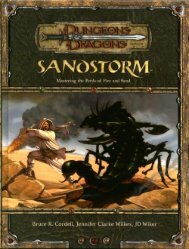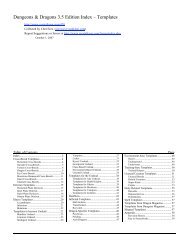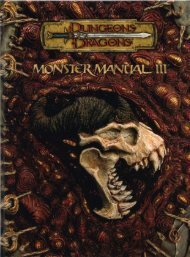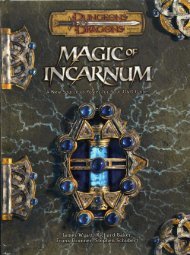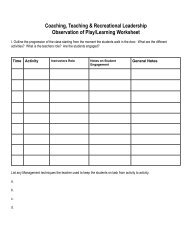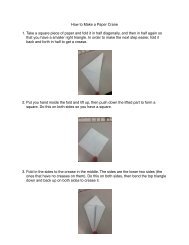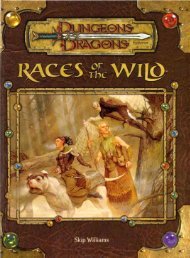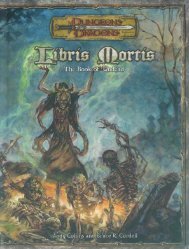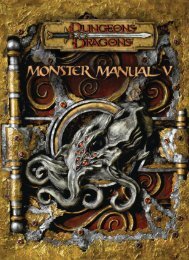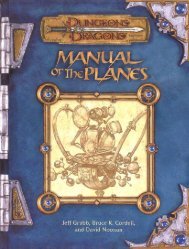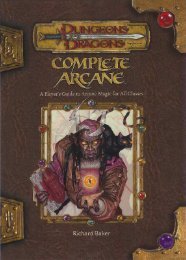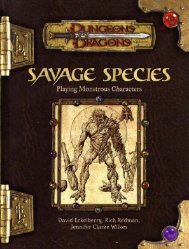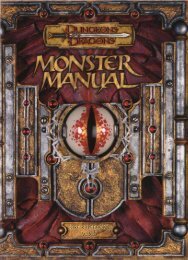Epic Level Handbook
Epic Level Handbook
Epic Level Handbook
- No tags were found...
Create successful ePaper yourself
Turn your PDF publications into a flip-book with our unique Google optimized e-Paper software.
CHAPTER 4:EPIC MAGICITEMSthe character who possesses the item is not true to thatalignment’s goals or the item’s special purpose, personalityconflict—item against character—results. Similarly,any item with an Ego score of 20 or higher always considersitself superior to any character, and a personalityconflict results if the possessor does not always agreewith the item.When a personality conflict occurs, the possessor mustmake a Will saving throw (DC = item’s Ego). If the possessorsucceeds, she is dominant. If she fails, the item is dominant.Dominance lasts for one day or until a critical situationoccurs (such as a major battle, a serious threat to either itemor character, and so on, at the DM’s discretion). Should aitem gain dominance, it resists the character’s desires anddemands concessions such as any of the following:• Removal of associates or items whose alignment orpersonality is distasteful to the item.• The character divesting herself of all other magic itemsor items of a certain type.• Obedience from the character so the item can directwhere they go for its own purposes.• Immediate seeking out and slaying of creatures hatefulto the item.• Magical protections and devices to protect the itemfrom molestation when it is not in use.• That the character carry the item with her on alloccasions.• That the character relinquish the item in favor of amore suitable possessor due to alignment differencesor conduct.In extreme circumstances, the item can resort to evenharsher measures.• Force its possessor into combat.• Refuse to strike opponents.• Strike at its wielder or her associates.• Force its possessor to surrender to an opponent.• Cause itself to drop from the character’s grasp.Naturally, such actions are unlikely when harmonyreigns between the character’s and item’s alignments orwhen their purposes and personalities are well matched.Even so, an item might wish to have a lesser characterpossess it in order to easily command him, or a higherlevelpossessor so as to better accomplish its goals.All magic items with personalities desire to play animportant role in whatever activity is under way, particularlycombat. Such items are rivals of each other, even ifthey are of the same alignment. No intelligent item wantsto share its wielder with others. An intelligent item isaware of the presence of any other intelligent itemwithin 60 feet, and most intelligent items try their best tomislead or distract their host so that she ignores ordestroys the rival. Of course, alignment might changethis sort of behavior. A holy devastator, for example, wouldcertainly not allow destruction of any other lawful gooditem and might encourage their discovery, even at therisk of having to face grim odds to do so.Items with personalities are never totally controlled orsilenced by the characters who possess them, eventhough they may never successfully control their possessor.They may be powerless to force their demands butremain undaunted and continue to air their wishes anddemands. Even a humble +1 weapon of unusual naturecan be a vocal martyr, denigrating its own abilities andasking only that the character give it the chance to shatteritself against some hated enemy.Note: You should assume the personality of the item asyou would with any NPC. Refer to Chapter 5: Campaignsin the DUNGEON MASTER’s Guide, especially Table 5–5: OneHundred Traits, for ideas on personality quirks to makean intelligent item’s persona more memorable.ARTIFACTSEven in a world with epic magic items, there will alwaysbe artifacts: legendary relics of mysterious power, theirorigins shrouded in tales of lore. Some of these items maybe little more than unique epic magic items with a storyattached, while others defy even the greatest loremasters’efforts to glean their methods of creation.Regardless of an artifact’s origin, no price can truly beattached to these items. In most cases, this is becausetheir powers flout categorization. Other items are so farBEHIND THE CURTAIN: PRICING ARTIFACTSSince epic magic items have market prices and prerequisitesfor creation, why don’t artifacts have these same characteristics?For most artifacts, this is a game balance issue. Becausean item’s market price sets its creation cost, pricing an artifactwould lead to setting its cost to create. If a character had theability to create books of exalted deeds or spheres of annihilation,the campaign (and indeed the entire world) could be thrownout of whack. The presence of such items must lie solely in thehands of the DM, who can decide whether or not he wants adeck of many things in his game. If these items had prices, thencharacters could create them as desired, taking this element ofcontrol away from the DM.Still, some artifacts (minor or major) can be reproduced usingthe epic magic item creation rules. For instance, the Mace ofCuthbert is essentially a +5 holy lawful mace of disruption (effectivelya +11 weapon) with a special power (searing light at 20thlevel at will). According to the epic magic item creation rules,this item would have a market price of approximately 2,500,000gp. A character who wished to wield a replica of the Mace ofCuthbert cojld have such an item created. It wouldn’t be theactual Mace, but it would be essentially identical in function.150



